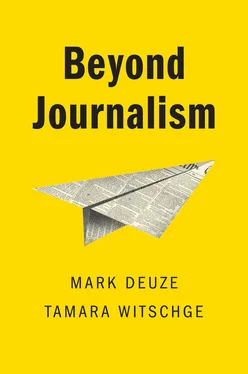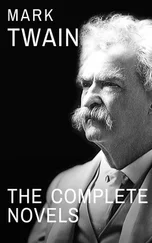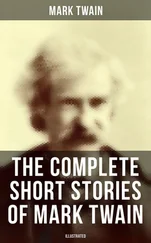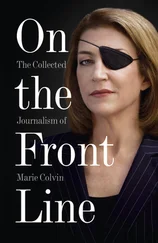The conceptual and theoretical building blocks of journalism studies, news values, framing and agenda setting, and occupational ideology can all be considered examples of routines, conventions, and formulas that developed (and continue to develop) – arising out of conversations in workplaces, debates in newsrooms, choices by individuals in a variety of circumstances. That is, these concepts and theories are continually contingent on practices. The ongoing and dynamic discursive construction of journalism as an idea as well as a praxis tends to be dictated by casuistry (rather than a strict principle-based approach) and everydayness . In Heideggerian (1927) terms, everydayness in journalism manifests in journalists’ generally pragmatic way of engaging the daily challenges of newswork. Lefebvre’s (1987) use of the concept of everydayness is relevant as well: how those engagements over time have a tendency to become repetitive, routinized, even monotonous – quite possibly soon to be replaced by automation and robot (or algorithmic) journalism (Carlson 2015).
Although this would suggest that one could equate “journalism” with the sum of routines, conventions, and formulas emerging from the newsroom-centric construction of the profession, we want to pinpoint and highlight all the other ways of understanding and doing journalism, being a journalist, that aren’t necessarily “peripheral” or even exceptional but simply also make up the essence of the profession. It can be argued that well-established patterned behaviors are what students and scholars may have focused on, and they may be what journalism education is structured around. Such behaviors may be what the major news institutions use to standardize work. In everyday practices, though, there is always what Robert Chia and Robin Holt call “wayfinding,” which they characterize “not as a plotted sequence of static positions but as the coming-into-sight and passing-out-of-sight of various contoured and textured aspects of the environment” (2009: 163). We run the risk of ignoring the many opportunistic, unplanned, improvised, intimate, and curious acts that make up journalism if we consistently attempt to solidify these into the well-worn concepts of our handbooks and canonical works (Chia and Holt label the models, maps, and classifications as the “navigational” behavior of professionals in organizations). Accessing practices through the lens of wayfinding underscores how institutional journalism is becoming a different place. Internally these institutions are reshuffling, being repopulated by a wide variety of new actors – often with only temporary assignments, working on a per-project basis. Journalism is increasingly practiced outside of such institutions. It is crucial to expand upon the exclusivity of journalism studies and education, to move beyond binaries, and seek out the stories and conversations of journalists elsewhere.
The navigational (Chia and Holt 2009) ties that bind journalism are the ones most efficiently theorized by the field of journalism studies, and consist of what journalists (and academics) know and understand to be the cornerstones of the profession: role perceptions and news values, ways of framing information that assist audiences to make sense of (particularly) the world of politics and the economy, and its purpose and corresponding privileged position in democratic society (Hanitzsch and Vos 2017). The theory and research falls short in that it conceptualizes these ties as necessarily operationally coupled with the structure of the news outlets and media organizations as an industry, and designates the institutional arrangement of news as work. Second, it does not allow enough space for understanding the many ways that journalistic practices and self-understandings defy these conceptualizations. In this book we thus call for acknowledging how our theoretical frameworks and empirical analyses exclude a great number of the practices, emotions, values, and definitions currently constituting journalism. We hope to contribute to the telling of multiple and multiperspectival (Gans 2011) stories about journalism so that we can contribute to the development of definitions and research frameworks that “do not foreclose on rearrangements suggested by new forms of social and natural knowledge” (Bowker and Star quoted in Timmermans 2015: 7).
Throughout its history, the general notion or idea of journalism has stayed more or less the same. Its core values and ideals remain intact. Its commitment to public service, truth-seeking, and providing information on the basis of professional and independent verification has been presumed and widely affirmed. In other words: when looking at journalism writ large, the tendency to see coherence is strong. When one switches to individual journalists – when the unit of analysis becomes what newsworkers do and under what conditions they do it – a messy reality emerges. Scholars such as Thomas Hanitzsch and Tim Vos acknowledge how the discussion about “what journalism is” changes when we take into account the profound and dramatic changes in journalists’ working environments. The question remains of how this could be, given the cognitive consensus about journalism and the continual “testing” of more or less new journalisms vis-à-vis a supposed core.
What is interesting (and what needs to be challenged) is not so much the question of what journalism is but how it has so successfully remained similar in the context of continuous internal and external transformations, changes, challenges, evolutions, and revolutions. It is revealing how the scholarly (and all too human) proclivity for closure and coherence has preferred to conflate the various levels of analysis when making sense of media work. This is most explicitly and famously articulated in several models: John Dimmick and Philip Coit’s (1982) taxonomy of mass media decisionmaking, Armin Scholl and Siegfried Weischenberg’s (1998) onion model, and Stephen Reese and Pamela Shoemaker’s (2016) hierarchy-of-influences framework. Instead of working through how the various stages of newswork change under individualized, fragmented, networked, and altogether precarious conditions, as educators and researchers we have tended to focus on consistency across levels, proclaiming more or less “universal” theories of journalism, its culture, and its role conceptions. In doing so, we have accepted explanations of newswork that assume journalists get their ideas of who they are and what they are (supposed to be) doing largely through occupational socialization and occupational context, leading to homogeneous understandings of what journalism is.
Whereas influential, multinational comparative research projects such as Worlds of Journalism ( worldsofjournalism.org) and Journalistic Role Performance ( journalisticperformance.org) started out with universalist ambitions, their most recent reports and publications suggest otherwise, emphasizing “multilayered hybridization in journalistic cultures” (Mellado et al. 2017: 961) and a world populated by a rich diversity of journalistic cultures (Hanitzsch et al. 2019). What these remarkable projects do not do, however, is to offer an explanation for all this diversity, hybridity, and complexity.
To provide insight into the many variations, seemingly contradictory definitions, activities, values, and aims that all exist under the banner of journalism, we suggest turning our attention to the affective dimension of news as work, of journalism as a profession. This affective dimension points to the strong affiliation that practitioners have to ideals of journalism, irrespective of the medium they produce for, their contract, or type of working arrangement. They can be quite critical of management, of industry, even of specific routines and practices associated with newswork – but they somehow see such criticisms as separate from their loyalty to – their passion for, even – the notion of doing journalistic work as a professional. In writing this book we have seen this most clearly among those who invent “journalism” from the ground up, sticking to quite traditional notions of newswork while making entire new companies, ventures, and collectives work. In this context legacy news organizations and newsrooms – while valuable and important – can also be a major distraction from reflecting on what exactly is (or also is) journalism. Once inside, the relative stability of the institutional setting absolves most journalists from actively questioning who they are, why they are doing what they are doing, and who they are doing it for. Consistently, those journalists operating in emerging or otherwise peripheral areas of the profession are challenged to be more reflective, deliberate, and articulate about what it is that they are doing. Those working on the inside, within the confines of the newsroom, have their positions governed by the institutional authority of their employer, and, though they are certainly involved in boundary work, can be considered to be less challenged to continuously legitimate what it is they are doing. This attitude is something Ellen Ullman once documented as the inherent blindness of being “close to the machine” (1997) – the machine in our case being the core of institutionalized newswork.
Читать дальше












